Those fibres known as semi-synthetic are regenerated from two types of naturally occurring materials: cellulosic materials such as trees, cotton and woody plants and proteins such as milk, soybeans and groundnuts. Both types are also known as regenerated fibres.
Fully synthetic fibres are manufactured primarily from petroleum or natural gas although, in response to the relatively recent search for more sustainable starting materials, they may also now be plant based. They differ however from those that are known as semi-synthetic or regenerated fibres because man, rather than nature, does the polymerisation.
Tables 1 to 3 include all classes of semi-synthetic and synthetic fibres which have been made in commercial quantities and are used as major components of textiles to date. Table 4 shows non-fibre materials that appear in the Documented garment exemplars as rubber substitutes or waterproofing.
The tables aim to capture in a simple and visually accessible way the complexity of the fibres' and materials' development, and the relationships between them. They include their commonly used names and starting materials, the characteristic part of the conversion process, the resulting fibre product, the most encountered trade names of the fibre or textile, and the date of first commercial manufacture, the company and the country. Frequently, different sources cite different facts in this respect. In particular, the beginning of commercial manufacture of a fibre is open to different interpretation thus these dates should be taken as a guide only.
Table 1: Cellulose-derived fibres (semi-synthetic)
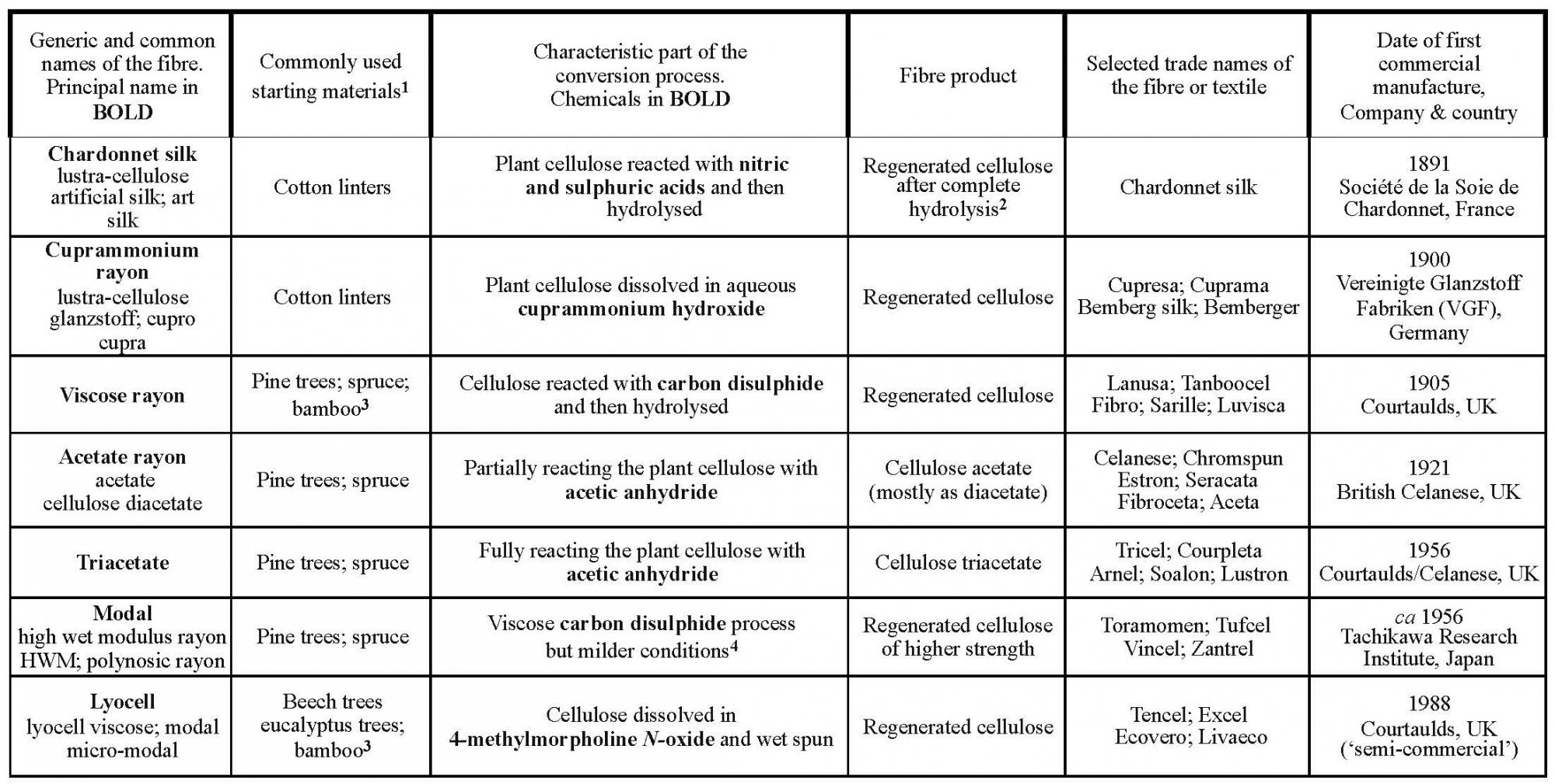
- Provided they can be pre-treated appropriately, other sources of cellulose (eg food waste) could be used as starting materials for any of these processes.
- Cellulose from cotton linters was converted to highly inflammable cellulose nitrate fibres (aka gun cotton!). These fibres then had to be further chemically treated (hydrolysed) to remove the nitro groups and so decrease the flammability. This part of the process would ultimately yield pure regenerated cellulose fibre. There is evidence that this was achieved although probably over a number of years.
- Bamboo can be converted to fibrous, cellulosic material suitable for spinning without involving any chemical treatments - a laborious, expensive and small-scale process at present. However, many bamboo textiles sold are regenerated cellulose (viscose), made using carbon disulphide. Bamboo can be also used in the Lyocell process.
- The principal changes adopted to improve wet strength are: no ageing or ripening steps; using weaker acids and alkalis; full stretching of the fibres.
Table 2: Protein-derived fibres (semi-synthetic)
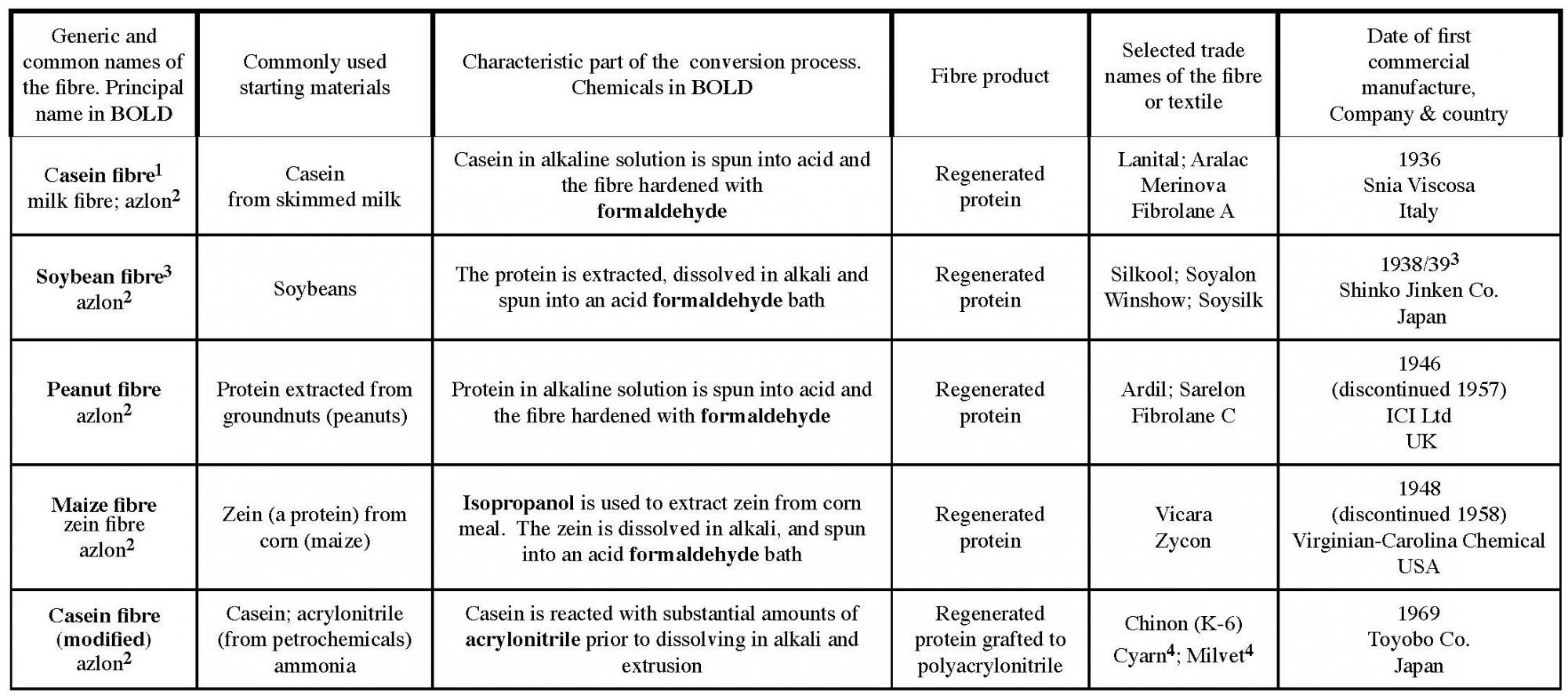
- A casein fibre made without formaldehyde, known as Qmilch, has been under development since 2013, but is not yet in commercial production (2022).
- Azlon is the generic name for all fibres made from regenerated proteins.
- Protein fibre from soybeans was also manufactured in 1939-1943 by Glidden Co. and Ford Motor Co. using Shinko Jinken Co.'s patent. In 2003 Shanghai Winshow Soybean Fibre Industry Co., China offered Soysilk and Winshow products.
- Cyarn and Milvet are recently introduced casein fibres and suspected to be modified with polyacrylonitrile or possibly some other synthetic polymer.
Table 3a: Synthetic fibres (introduced 1928-1940)
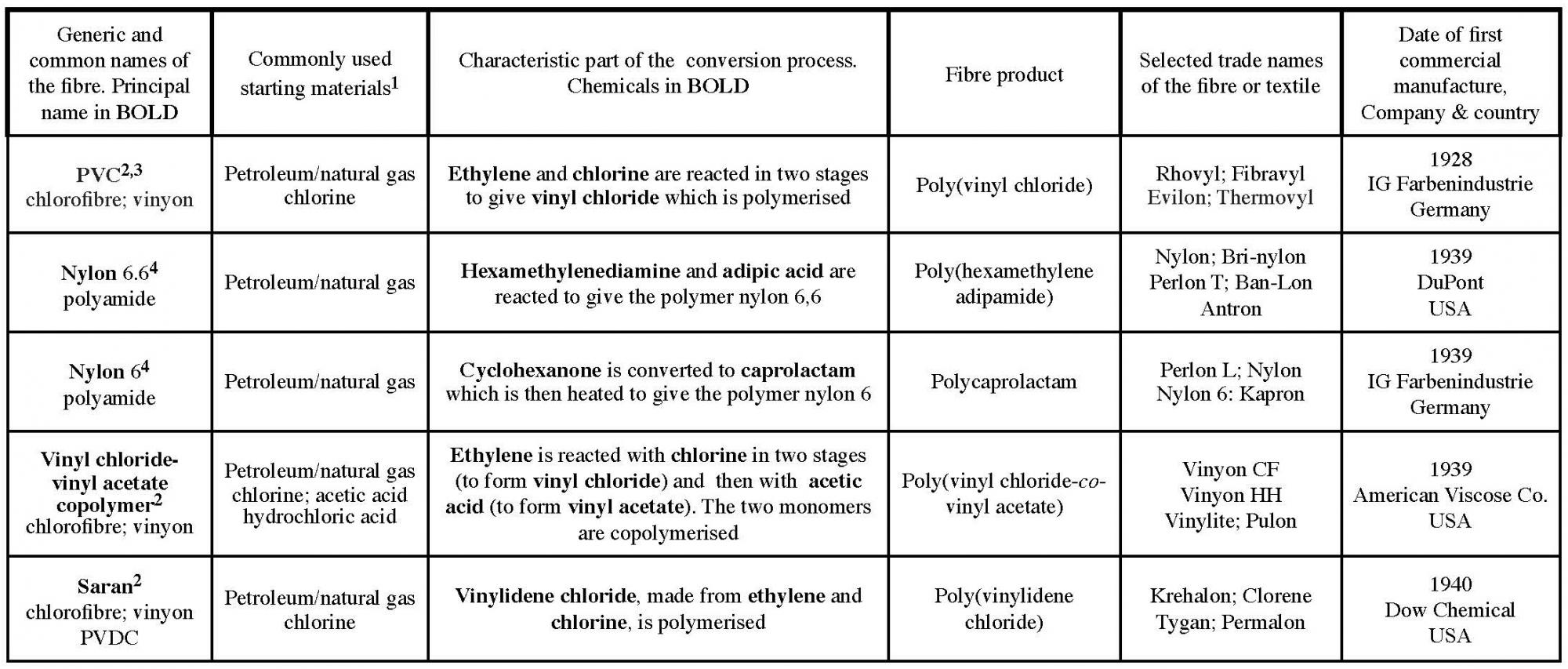
- Only the starting materials used today (2022) are shown. However, prior to WW2, coal was the main starting material. After the war, petroleum and natural gas gradually replaced coal. In the 21st century, plant-based alternatives to all fossil fuels are actively being considered as raw materials.
- PVC, polychloroprene, Saran, vinyl chloride-vinyl acetate copolymer and modacrylic fibres (see Table 3b) have low flammability because of their chlorine content.
- PVC, when plasticised, is also widely used as a coating for textiles - see Table 4.
- The number(s) following 'nylon' indicate the raw material used. Nylon 6,6 is made from two components each containing 6 carbon atoms, hexamethylenediamine and adipic acid. Nylon 6 is made from one component of 6 carbon atoms
Table 3b: Synthetic fibres (introduced 1941-1950)
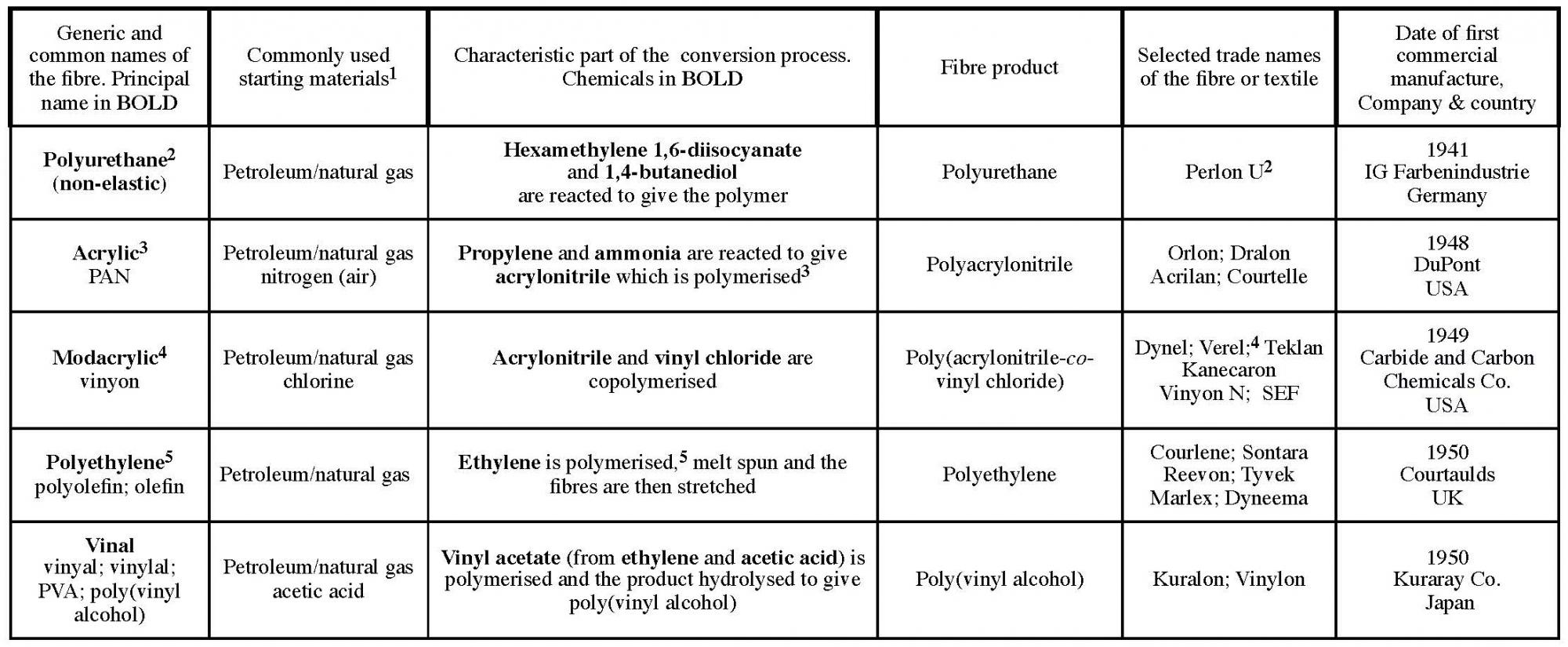
- Only the starting materials used today (2022) are shown. However, prior to WW2, coal was the main starting material. After the war, petroleum and natural gas gradually replaced coal. In the 21st century, plant-based alternatives to all fossil fuels are actively being considered as raw materials.
- Perlon U was a short-lived fibre similar to nylon, discontinued after WW2. However, polyurethanes based on a macroglycol, a diisocyanate and a diamine, provide elastic fibres or coatings, and were developed later - see Elastane, Table 3c.
- Acrylic fibres are composed of acrylonitrile usually co-polymerised with minor amounts (<15%) of other monomers which provide better properties such as ease of dyeing. However, when the co-monomer content is >15% the fibres are known as modacrylics.
- Modacrylic fibres together with PVC, polychloroprene, Saran and vinyl chloride-vinyl acetate copolymer have low flammability because of their chlorine content. In some modacrylics, eg Verel, some of the vinyl chloride is replaced by vinylidene chloride which contains more chlorine than vinyl chloride.
- Polyethylene was originally made by subjecting ethylene to very high pressures; fibres such as Courlene were produced from it. Stronger, higher melting point fibres were later produced at low pressures using special catalysts; the first of these fibres was known as Marlex 50. Later, super strong polyethylene fibres of very high molecular weight, such as Dyneema (DSM) were introduced.
Table 3c: Synthetic fibres (introduced 1952-1994)
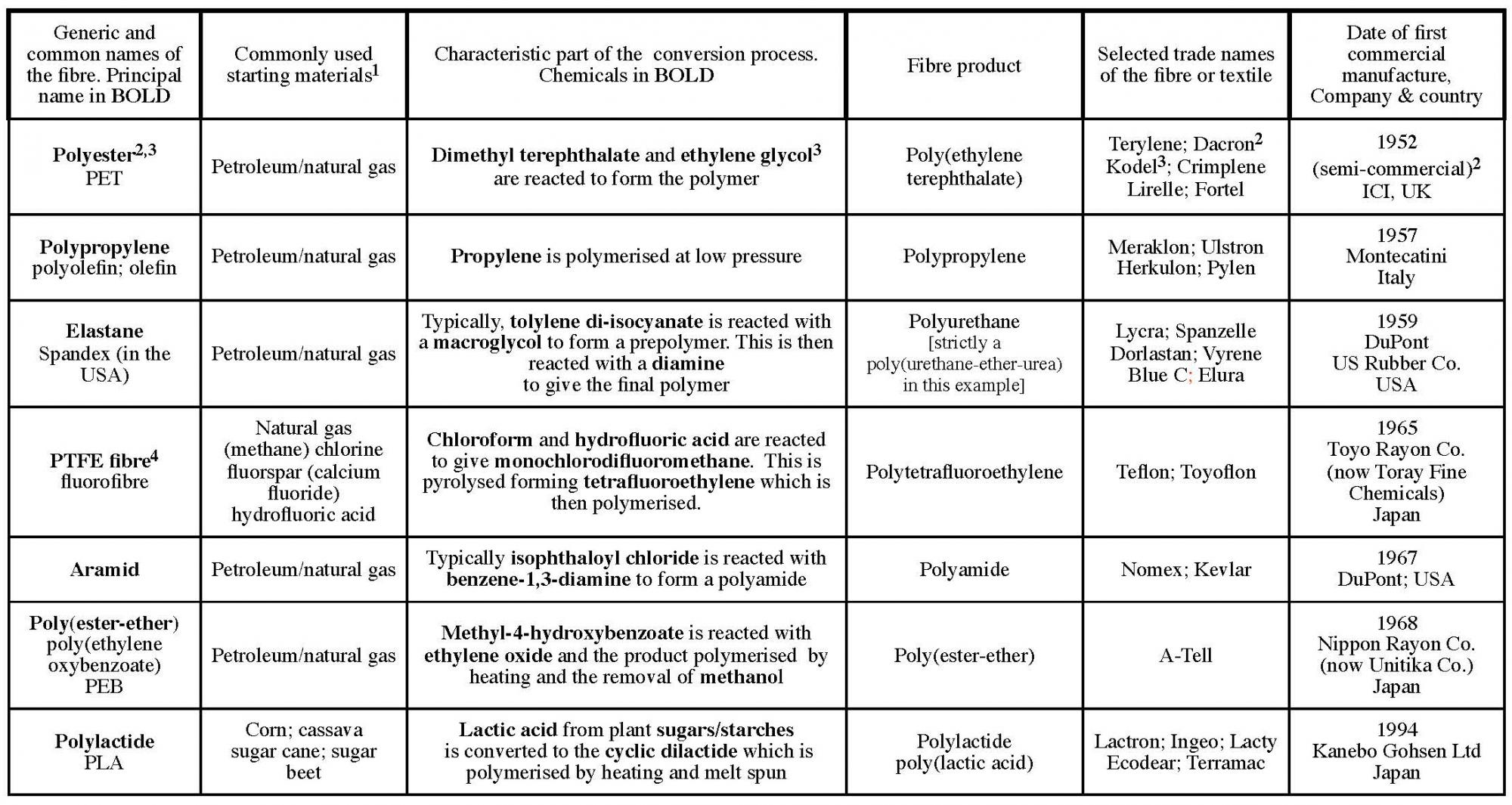
- Only the starting materials used today (2022) are shown. However, prior to WW2, coal was the main starting material. After the war, petroleum and natural gas gradually replaced coal. In the 21st century, plant-based alternatives to all fossil fuels are actively being considered as raw materials.
- Polyester fibre was patented by The Calico Printers' Association in the UK in 1941. The patent was sold to ICI who developed the fibre as Terylene in the UK and by 1952 limited quantities had been sold. By 1953, under licence from ICI, DuPont had established full commercial production of polyester fibre in the USA, calling it Dacron.
- Polyester fibre was also made in the USA by Eastman Kodak using 1,4-cyclohexanedimethanol in place of ethylene glycol and sold under the name Kodel in 1958.
- See also PTFE membrane, Table 4.
Table 4: Selected non-fibrous synthetic polymers used in clothing (1)
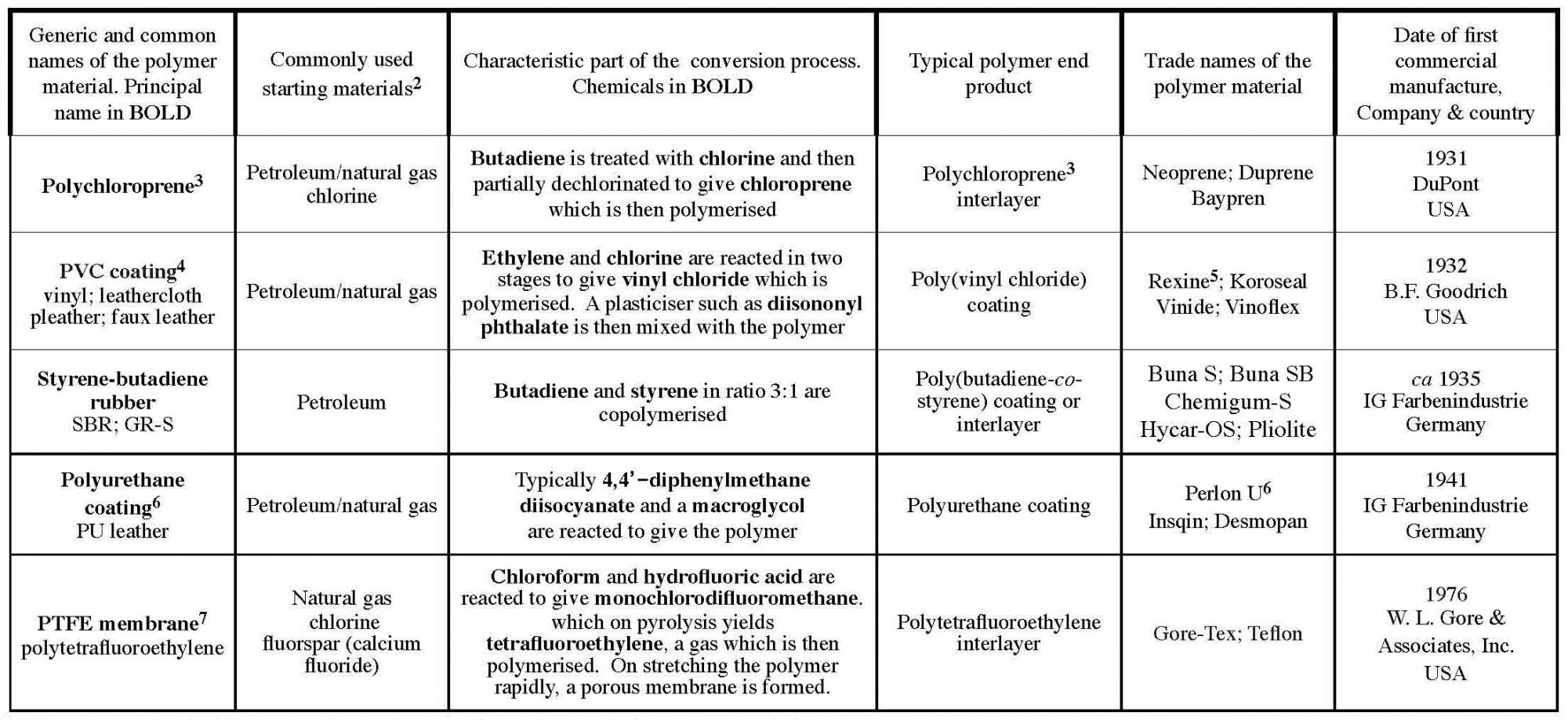
- The polymers in this table are used in the form of films, either as fabric coatings or interlayers.
- Only the starting materials used today (2022) are shown. However, prior to WWII, coal was the main starting material. After the war, petroleum and natural gas gradually replaced coal.
- Polychloroprene is widely used for wet suits. It has good fire-resistance.
- PVC fibres were first made commercially in 1928, but plasticised PVC was discovered later by Waldo Semon at B.F. Goodrich in 1932. Also note PVC fibre (Table 3a).
- Rexine was originally the trademark of a fake leather made using plasticised cellulose nitrate spread on cotton cloth, but by 2022 similar PVC coatings were sometimes also referred to as Rexine.
- Polyurethanes are diverse polymers, originally invented in 1941 at IG Farbenindustrie. Perlon U is a fibre, whereas Insqin is a polyurethane dispersion for coating textiles.
- Also note PTFE fibre (Table 3c).
